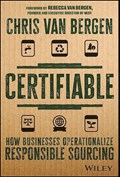- Operations
Sourcing Supply Responsibly
A practical guide to sustainable corporate sourcing and running a scandal-free supply chain
At a time when sustainability is a watchword for business, built-in obsolesce really has no place. But lapses in corporate responsibility come in many forms. As with the Nike soccer ball scandal, one recurring source of trouble is the supply chain. Business leaders under pressure to find competitive edge while avoiding scandal walk a fine line, and managing complicated global supply chains can be where they trip up.

The key to ensuring a clean reputation, while still delivering on the bottom line, is the maintenance of effective responsible sourcing practices across the firm’s supply chain.
In his new book, Certifiable: How Business Operationalize Responsible Sourcing, Chris van Bergen, a professor at NYU Stern School of Business, discusses how to create, implement, and audit sourcing practices that are not only environmentally sustainable and socially responsible but offer enhanced competitive advantage.
The book is not a vague call for an ESG Utopia. Rather it is a precise look at the dynamics of global procurement and sourcing and at the practical processes and systems required to transform an organization and its supply chain to be consistently responsible across all its operations. Central to Van Bergen’s approach is a focus on transparency. Managers cannot possibly have eyes and ears everywhere but creating systems of standard setting and auditing that increase transparency across the supply chain, builds trust, and is the way managers can best keep tabs on maybe hundreds of suppliers and producers around the world.
Framing his welcome focus on practical solutions, Van Bergen provides valuable historical context, taking us through the evolution that led to today’s thinking about supply chain transparency and responsible sourcing. He describes several corporate sourcing disasters where brands lost control over sub-contacting or relied on poor local regulation rather than creating and enforcing their own systems. While unfettered globalization might be seen to be the cause of these calamities, during the same time there were companies, described here, that instituted innovative policies that ensured good ethical practice.
Looking to the future, the book considers where corporate sourcing strategies are headed now that the world has become so much more aware of its social and environmental responsibilities, and corporate stakeholders more aware of reputational damage. With developments such as near-sourcing now being facilitated by technology and efforts towards a circular economy coming good, there are reasons to be optimistic. Yet in an era of extraordinary technological change—where workers can be replaced by machines—and at a time of alarming climate change, it is essential that business leaders and supply chain managers remain vigilant.
Van Bergen writes not only from the perspective of a business school professor and supply chain expert, but also as COO and CFO of Nest Inc., a global nonprofit working with the artisan and handworker economy to offer a service to the wider business community. “Nest’s programs are bringing radical transparency, data‐driven development, and fair market access to a fragmented industry, enabling handwork’s unmet potential to improve our world.” As with Nest this book, although based on altruistic theory, is fundamentally about practical implementation.
……………………………………………………………………………………………………………
DEVELOPING LEADERS QUARTERLY MAGAZINE AND WEEKLY BRIEFING EMAILS

































